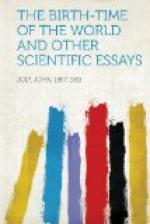It is no more than a step to show that bound up with the radioactive energy are most of the earthquake and volcanic phenomena of the earth. The association of earthquakes with the great geosynclines is well known. The work of De Montessus showed that over 94 per cent. of all recorded shocks lie in the geosynclinal belts. There can be no doubt that these manifestations of instability are the results of the local weakness and flexure which originated in the accumulation of energy denuded from the continents. Similarly we may view in volcanoes phenomena referable to the same fundamental cause. The volcano was, in fact, long regarded as more intimately connected with earthquakes than it, probably, actually is; the association being regarded in a causative light, whereas the connexion is more that of possessing a common origin. The girdle of volcanoes around the Pacific and the earthquake belt coincide. Again, the ancient and modern volcanoes and earthquakes of Europe are associated with the geosyncline of the greater Mediterranean, the Tethys of Mesozoic times. There is no difficulty in understanding in a
142
general way the nature of the association. The earthquake is the manifestation of rupture and slip, and, as Suess has shown, the epicentres shift along that fault line where the crust has yielded.[1] The volcano marks the spot where the zone of fusion is brought so high in the fractured crust that the melted materials are poured out upon the surface.
In a recent work on the subject of earthquakes Professor Hobbs writes: “One of the most interesting of the generalisations which De Montessus has reached as a result of his protracted studies, is that the earthquake districts on the land correspond almost exactly to those belts upon the globe which were the almost continuous ocean basins of the long Secondary era of geological history. Within these belts the sedimentary formations of the crust were laid down in the greatest thickness, and the formations follow each other in relatively complete succession. For almost or quite the whole of this long era it is therefore clear that the ocean covered these zones. About them the formations are found interrupted, and the lacuna indicate that the sea invaded the area only to recede from it, and again at some later period to transgress upon it. For a long time, therefore, these earthquake belts were the sea basins—the geosynclines. They became later the rising mountains of the Tertiary period, and mountains they
[1] Suess, The Face of the Earth, vol. ii., chap. ii.
143




